The Great Grapevine Road Fight, Part III

Tarrant County Forges Ahead
The initial cost of putting in the new road from Anderson’s Corner to Grapevine was $70,000. Commissioner Wall had saved $60,000 out of the Tarrant County road and bridge fund, and the State Highway Commission found it so unusual for so much of this money to be saved that it decided to match the cost dollar for dollar. In February 1927, Tarrant County commissioners decided that instead of waiting until an audit of the State Highway Department made state funds available the following autumn, they would select the right-of-way for the Grapevine stretch of the road. It would be the first link in the improved road to be graded, drained, and graveled. Doing so would allow the roadbed to settle and be traveled for at least a year before the hard surface was laid using state and federal funds. Grading would start in May 1927.
On February 25, the Grapevine Chamber of Commerce called a meeting wherein about 122 citizens from Grapevine and Fort Worth met at the Grapevine Woodmen of the World Hall, with B. R. Wall (no relation to Sandy Wall) of Grapevine presiding. Both businessmen and residents agreed that the Grapevine end of the highway work should be completed in the shortest possible time, and that the road should be continued on to McKinney. A committee was appointed by the Chamber of Commerce to work with Commissioner Sandy Wall and the Fort Worth Chamber in order to cooperate in the effort. B. R. Wall observed that the necessity of building this road was being seen more and more each day. Engineer Damon A. Davis explained that the proposed road would run under the Cotton Belt line and would not include grade crossings. The new road would shorten the route to Grapevine by 1.8 miles and eliminate forty-three right angle turns, including fourteen right angle turns in the last nine miles, from the A. J. Anderson farm to Grapevine. Davis also presented basic facts and figures to show how advantageous the road would be in terms of dollars and cents, thus paying for itself. Mayor Ernest E. Lowe quipped that traveling the current road made him “road dizzy.” Most importantly, it seems, minister Pat Leach of Grapevine’s Methodist Church challenged everyone in Grapevine to think of the future and not repeat the nearsightedness of the preceding generation.
The first step in the acquisition of right-of-way was the drafting of a road map that showed the exact amount of land necessary from each farm site to get the complete highway. By early March, plans for the proposed road improvement were underway. On March 13, the Dallas Morning News reported that work would start immediately on the new road, designated as State Highway No. 121. The State Highway Commission made the new road name official on March 16. On April 25 it approved state aid for $35,000, half of the road’s cost, on condition that Tarrant County advance the funds and carry them until 1928 and until state funds were available. At that time, the state would rebate that amount on condition that the county contribute $35,000 to the nine-mile construction project.
County Engineer Davis made surveys showing how the new road would take a direct course into Grapevine and would be reconstructed from Grapevine nine miles southwest to the Anderson farm. The tentative route was from Anderson’s corner northeast in a straight run to Pleasant Run, thence northeast to the Cotton Belt Railway on a line a quarter of a mile west of Bear Creek, then parallel with the railway tracks to Grapevine. The railway underpass would be about twenty feet wide and have fourteen feet clearance, and would eliminate a dangerous grade crossing into town.
Construction was scheduled to begin on May 1, 1927. Commissioner Wall said that state funds totaling $35,000 would be available no later than January 1, 1928. No federal aid was sought.
Road work would involve straightening the road by grading a new dump and graveling it. The state’s portion of the funds would be used to lay a hard surface after the dump shrank. The new road would be built parallel with the Cotton Belt Railway because work undertaken on the road called for a subway to be built under the railway at a point where the new highway would enter Grapevine. Blueprints for the subway were sent to J. F. Montgomery, division engineer for the Cotton Belt.
At the end of April 1927, the Highway Commission provided $100,000 on two Tarrant County highway construction projects, one being State Highway No. 121, which was allotted $35,000. However, in late May Tarrant County judge Hal S. Lattimore ruled that a county or the state could not condemn road right-of-way for a greater width than sixty feet. Commissioner Wall asserted that modern highways needed more than sixty feet to meet traffic demands, and was in favor of a new law establishing that need. On June 2 the Tarrant County commissioners passed a resolution stating that the Grapevine Road was a first-class road, and as such, should be made eighty feet wide. About the same time, a new state law went into effect providing from that point forward, cardinal highways (north-south and east-west) in Texas could be built to a maximum width of eighty feet wide instead of sixty feet. This meant that the right-of-way for the reconstruction of the new road from the Anderson farm to Grapevine could be acquired for an eighty-foot road. An editorial in the June 20, 1927 Fort Worth Star-Telegram endorsed the new road improvement program as a necessary component to growing vehicle transport and economic growth in Tarrant County (Figure 1).
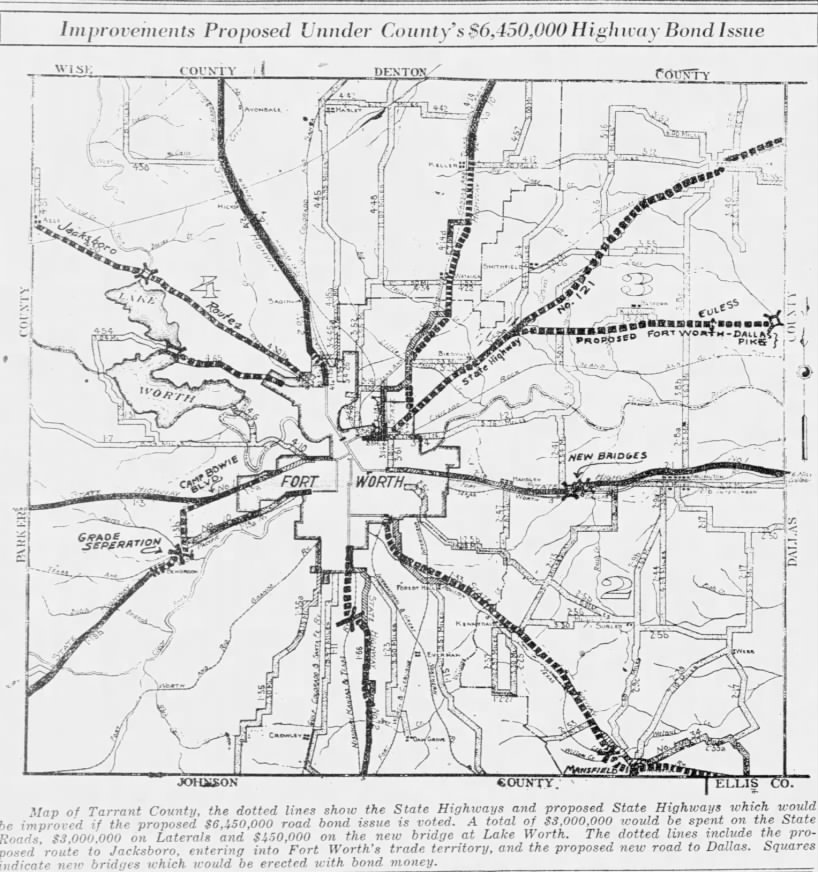
Mapping Out The Program
Commissioner Sandy Wall wanted a citizens’ advisory committee to be formed with representatives from every section of the county to work with the commissioners in mapping out a fixed road program. The program would be followed in road construction and rebuilding before a bond issue was presented for a public vote. Wall also advocated short-term bonds of no more than thirty years so road debt would not outlast the roads themselves. In late July the commissioners recommended passage of a $6,450,000 highway and bridge bond issue provided it was properly petitioned by at least fifty eligible voters to call a special election.
On August 1, thirty-seven Tarrant County men were appointed to the citizens’ advisory committee, including D. E. Box and Mayor Ernest Lowe of Grapevine, all of whom approved the bond issue on August 3. Mr. Box opposed the proposed use of concrete on subcardinal roads as its cost would exceed the amount of the bonds. He was also appointed to a nine-member subcommittee responsible for reporting action taken by the advisory committee to the commission. County Judge S. D. Shannon declared that the bond election would be held on or about October 1, 1927 but it was delayed indefinitely pending a report from the citizens’ advisory committee pertaining to the election.
In late December 1927, the four-mile strip between Grapevine and Coppell was graveled, thus moving another step toward completion of the new highway from Fort Worth to McKinney. From Fort Worth to Grapevine the road would be paved. It would also be paved from Coppell to Richardson, and finally, a hard-surface highway to McKinney would finish the project.
“For the first time in the history of Tarrant County,” the Fort Worth Star-Telegram proclaimed on January 1, 1928, “and probably of the entire State, a major road (the eleven-mile strip from Anderson’s Corner to Grapevine) will be built within a few months for cash.” Called “innovative” by county officials, this action by Commissioner Sandy Wall was considered the forerunner of application of strictly business methods to local government operation. Having been both a country banker and businessman, the commissioner had been prudent in his spending of public monies. He, “by economy”, had saved $55,000 through judicious financial management of his precinct’s funds. County officials roughly estimated that by building a road for cash, taxpayers would be given about two dollars for one dollar in improvements compared to doing so on long-time credit.

In mid-February 1928, draftsman L. H. Crawford filed plans and specifications for the new highway with the State Highway Commission. From Anderson’s Corner it would be projected north of the Cotton Belt Railroad tracks, then run parallel with the railroad to a point just south of Grapevine’s business district where an underpass would be built under the railway for entering Grapevine. The first job would be grading and laying of drainage and laying of a rock and gravel base on which a hard surface paving would be placed. It had taken eighteen months to obtain the right-of-way accomplish these tasks, which caused several months’ delay.
In early April 1928 the urge for an election to vote on county road bonds increased when it was realized that the state highway heading northeast of Grapevine would pass through the northwest corner of Dallas County, and the route from Dallas to Rhome would pass through a corner of Tarrant County. Neither Dallas’s nor Tarrant County’s bond money could be spent for the other’s road work, so if Tarrant County’s bond issue passed, the two counties would pave the parts of these roads that fell inside their own borders.
The contract for nine miles of grading and drainage work was let by the State Highway Commission on April 24 to Patterson & Gage of Corsicana for $32,196.68. The commission also designated the road from Grapevine to McKinney as the Fort Worth Northeast Highway on condition that counties through which the road passed would share the cost. The highway would run from Fort Worth to Grapevine, through the northwest corner of Dallas County to McKinney, and thence to Bonham and across the Red River to Oklahoma. Tarrant County stated that this project would open up rich livestock and agricultural areas and allow farmers to diversify their production.
The Program Goes To The Voters
On May 16, Tarrant County commissioners called for June 15 as election day for the road bonds, since more than enough voters had signed a road petition, thus requiring the commission to set an election date. Two days later notices were posted in courthouses in Grapevine, Arlington, Crowley, and Fort Worth. The bonds would bear interest at a rate of 4.25 percent per year, and only property-owning taxpayers would be allowed to vote. Generally it was believed that the road program was balanced county-wide and the bond issue would pass, but there could be some opposition claiming provision should be made for paving some important lateral highways. Mayor Lowe of Grapevine (Figure 4) supported the program as it stood and urged its passage. The present road system, he asserted, had outlasted its purpose. Grapevine banker D. E. Box believed that his neighbors favored it only to a certain extent, including the extension to McKinney, because of concern over the lateral roads. Improving the route of the Grapevine Road from Fort Worth to the Dallas County line would cost $881,119.
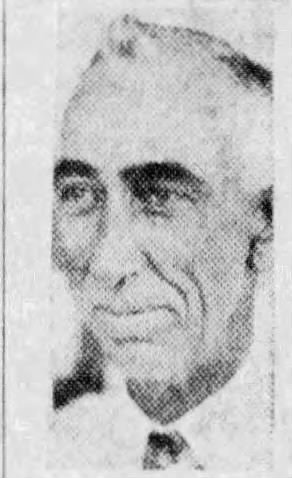
Most county residents had realized that their road system had become outdated. Even though small changes had been made over time, the main system had been laid out in 1919 when there were only about 2,000 vehicles on the road. Speeds were slow, and right-angle turns and narrow roads were not a safety concern. There was little inter-city traffic and hardly any interstate traffic. Almost ten years later, 45,000 vehicles were traversing the county, and they weren’t wagons pulled by horses. Roads were narrow and crooked, and right-angle curves were now seen as “death traps.” So important was this issue to Tarrant County that the Star-Telegram ran a nine-part series beginning May 17 that discussed various aspects of the bond issue.
On May 24, Commissioner Wall announced that the grading and drainage portion of State Highway No. 121 from Anderson’s Corner to Grapevine would take about one hundred days. The new road would cross the old one seven times where sharp turns had previously existed. The proposed underpass below the railway tracks would eliminate one of seven county-wide grade crossings and cost $24,000; the expense would be shared by both county and state.
The “narrow, frayed, meandering road to Grapevine” received much attention, but even though the community stood to benefit from the bond issue, nobody outside of a number of Grapevine businessmen was believed to be in favor of it. Faced with a remote possibility of even a slight tax increase, many residents would flatly reject it. Mayor Lowe called the new road “a dream come true” for Grapevine but observed that to others, the Fort Worth-McKinney highway was “a spite road and is not justified.” When Grapevine voters went to the polls at the Woodmen of the World Hall on June 15, they rejected the issue 68 to 118 against the bonds, but the issue passed the county with a two-thirds majority.
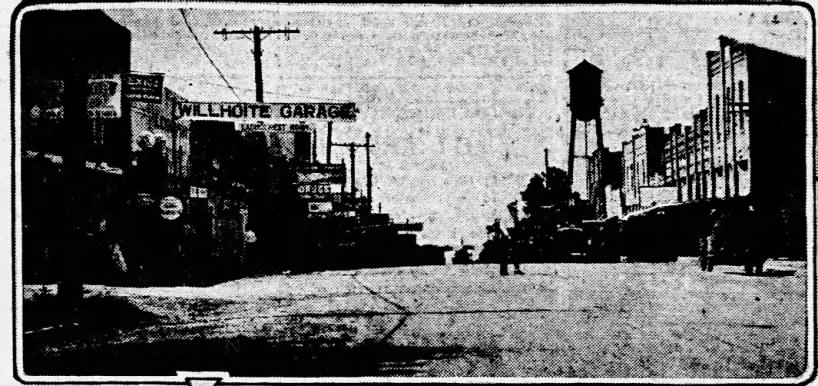
Tarrant County Gives The Green Light
Now that the bonds had been approved, work on the Cotton Belt underpass was scheduled to start within a few days. The contract between the county and the railroad was signed on April 9 and filed on June 13 in the County Clerk’s office. The underpass, located about 400 yards west of the Grapevine depot, would be thirty feet wide and paved. The railroad would do the construction, which would take about four months, and the county would handle the paving.
The first work would be done on the Fort Worth-Jacksboro and Fort Worth-McKinney roads because both would extend into new trade territories. In late September 1928 the state allotted $600,000 in road aid to Tarrant County out of the $4,290,000 bond issue. State aid money would be distributed over two and one-half years for the entire Tarrant County road system except for the Grapevine and Tarrant-Jack County road. A two-member county committee was appointed in early October to design the new bonds and send the design to the court for approval. Grading and building of drainage structures were well under way.
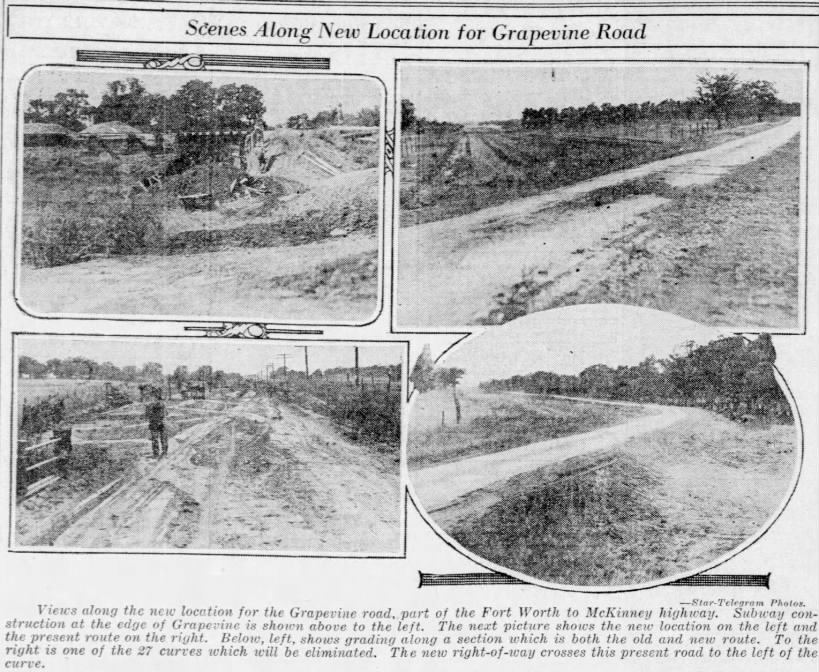
By mid-October 1928, Commissioner Wall reported that work was “progressing nicely.” As of December 13 the new roadbed of State Highway No. 121, including the Fort Worth to Grapevine Road, had been nearly completed from the Anderson farm to Grapevine, so the paving would be finished soon by sprinkling and rolling. At the same time, Commissioner Wall was working on obtaining construction of the Grapevine Road. Most of the new location had been graded and drainage structures built.
In the December 25 issue of the Star-Telegram, a news writer compared Christmas of 1878 and Christmas of 1928 in terms of government and business, including road improvement. Just prior to Christmas 1878, the Commissioner’s Court called a “jury” or committee to come up with plans to improve the “Birdville-Grapevine Road” and convert it into a second-class road. The court minutes didn’t indicate whether any changes were made, but the sharp turns existing at that time still existed in 1928. Fifty years later, the road was being improved again, but this time into a first-class road comparable to any in Texas – and this time the sharp turns would be gone.
Work was finally underway on the new State Highway No. 121. In the next blog we’ll see see how smooth or bumpy the road to the new road would be.


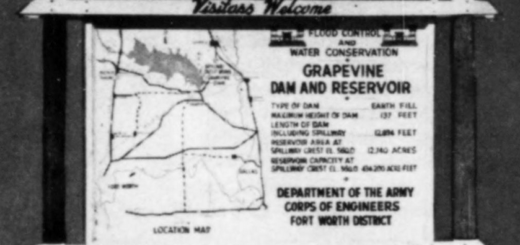

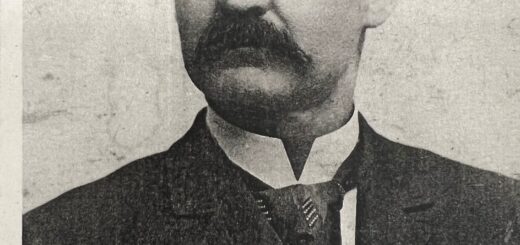
Recent Comments